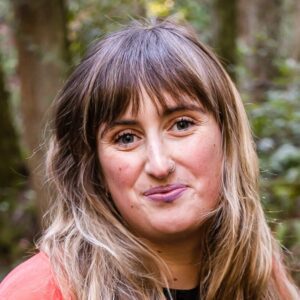Upon entering Whatcom Museum’s Old City Hall, visitors’ eyes will immediately gravitate to a room of kaleidoscopic colors, arresting faces and wild animals. This room is small, with 13 large oil paintings swallowing the space. Still, the viewer cannot help but be intoxicated by the striking imagery.
These paintings are the works of Alfredo Arreguín, a Mexican-American artist born in Mexico who immigrated to the Pacific Northwest at 21. After he died in 2023, his estate gifted six paintings to the Whatcom Museum. Now these paintings, plus seven borrowed pieces, are available for public view for the first time.

Each work features Arreguín’s unique architectural style, built of a sort of lacework that becomes part of every image. Curator Amy Chaloupka chose the exhibit’s title, “The Exquisite Veil/El Velo Exquisito,” to capture this aspect of Arreguín’s work. She worked closely with Arreguín’s widow, the painter Susan Lytle, and noted how “[Susan] was pleased with that title and thought that Arreguín would like it, too.”
Chaloupka describes the exhibit as “a sampling across his career with examples of landscapes, portraiture, and works of abstract patterns and texture.” It is not a comprehensive look at his career, but rather gives a nice introduction to someone who might not be familiar with his work.
While Arreguín is nationally acclaimed and regarded as an icon of this region among artists, Chaloupka said some of the general public may not yet know his work. She hopes that “The Exquisite Veil” will help audiences recognize him: “He had such a unique way of painting that when you look at one of his works, you just know it’s an Arreguín,” Chalpouka continued.
Arreguín’s work is both mythic and personal. The paintings draw from his childhood in Mexico and are often populated with jaguars, birds and other colorful wildlife, while others pull in flora and fauna from the Pacific Northwest, which he loved and spent most of his life in. There are even nods to Coast Salish and Japanese culture. One of the central themes of the exhibit and Arreguín’s work is ecological protection. He often incorporated Spanish Catholic History, pre-Columbian history and iconography.


Arreguín would paint figures that looked like saints, but were usually famous Mexican artists and activists, like Frida Kahlo (featured in this exhibit), surrounded by jungle life. Chaloupka explained that Arreguín talked about these “saints” as “being a representative or a protector of nature, or like the Saint of protecting the environment. He would take these iconographies and use them for his own devices and purposes in his work.”
When you look at the paintings, they are built of patterns — as if, bit by bit, he painstakingly created imagery from repeating shapes and colors. However, Arreguín’s process was the exact opposite. He would sketch out and grid significant aspects of the composition of each painting, then add patterns. This part of the process was very intuitive for him: Arreguín had a lexicon of imagery he drew from, including the vibrant colors to which he gravitated. By the end, each painting looks architectural but alive.
The exhibit is in Spanish and English, and Spanish tours are available to visitors upon request. Arreguín wanted strong Mexican figures featured in American museums: He often painted Mexican icons (such as Cesar Chavez) to highlight the importance of their activist and social justice work, and to point out that these figures are essential not just to Mexican Americans, but to all Americans.

Chaloupka purposefully placed Spanish text before English to honor this part of Arreguín’s mission.
“It upends the dominant culture, which I want people to be cognizant of,” Chaloupka said. “If you’re used to everything being presented to you and in a way that best suits you, it’s great to acknowledge that that’s not always the case for everybody.”
“The Exquisite Veil/El Velo Exquisito” will be on view until July 6. Though small, the exhibition is worth visiting a few times, just to take in the incredible details of each painting. As Arreguín said in his own words, “There are so many harsh and horrific things happening in the world. When I enter my canvas, I enter the spiritual world where there is no struggle.”
Old City Hall is open noon to 5 p.m. Wednesday–Sunday at 250 Flora St. “The Exquisite Veil/El Velo Exquisito” is on view from Jan. 25–July 6, 2025. Info: whatcommuseum.org.





